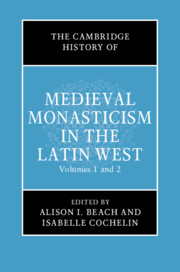Book contents
- The Cambridge History of Medieval Monasticism in the Latin WEST
- The New Cambridge History of Medieval Monasticism in the Latin West
- The Cambridge History of Medieval Monasticism in the Latin WEST
- Copyright page
- Contents
- Figures
- Contributors
- Acknowledgments
- Abbreviations
- 1 General Introduction
- Part I The Origins of Christian Monasticism to the Eighth Century
- Part II The Carolingians to the Eleventh Century
- Part III The Long Twelfth Century
- Part IV Forms of Monasticism in the Late Middle Ages
- 50 Late Medieval Monasticism: Historiography and Prospects
- 51 Sources of Late Medieval Monasticism
- 52 Monastic Liturgy, 1100–1500: Continuity and Performance
- 53 Books and Libraries within Monasteries
- 54 Art in Monastic Churches of Western Europe from the Twelfth to the Fourteenth Century
- 55 Lay Brothers and Sisters in the High and Late Middle Ages
- 56 Female Religious Life in the Twelfth and Thirteenth Centuries
- 57 Striving for Religious Perfection in the Lay World of Northern Europe
- 58 Monks and the Universities, c. 1200–1500
- 59 Bishops, Canon Law, and the Religious, c. 1140–1350
- 60 Daily Life in Late Medieval Monasteries
- 61 Monastic Preaching, c. 1350–1545
- 62 Research on Monasticism in the German Tradition
- 63 Satirical Depictions of Monastic Life
- 64 A Crisis of Late Medieval Monasticism?
- Index
- References
56 - Female Religious Life in the Twelfth and Thirteenth Centuries
from Part IV - Forms of Monasticism in the Late Middle Ages
Published online by Cambridge University Press: 16 January 2020
- The Cambridge History of Medieval Monasticism in the Latin WEST
- The New Cambridge History of Medieval Monasticism in the Latin West
- The Cambridge History of Medieval Monasticism in the Latin WEST
- Copyright page
- Contents
- Figures
- Contributors
- Acknowledgments
- Abbreviations
- 1 General Introduction
- Part I The Origins of Christian Monasticism to the Eighth Century
- Part II The Carolingians to the Eleventh Century
- Part III The Long Twelfth Century
- Part IV Forms of Monasticism in the Late Middle Ages
- 50 Late Medieval Monasticism: Historiography and Prospects
- 51 Sources of Late Medieval Monasticism
- 52 Monastic Liturgy, 1100–1500: Continuity and Performance
- 53 Books and Libraries within Monasteries
- 54 Art in Monastic Churches of Western Europe from the Twelfth to the Fourteenth Century
- 55 Lay Brothers and Sisters in the High and Late Middle Ages
- 56 Female Religious Life in the Twelfth and Thirteenth Centuries
- 57 Striving for Religious Perfection in the Lay World of Northern Europe
- 58 Monks and the Universities, c. 1200–1500
- 59 Bishops, Canon Law, and the Religious, c. 1140–1350
- 60 Daily Life in Late Medieval Monasteries
- 61 Monastic Preaching, c. 1350–1545
- 62 Research on Monasticism in the German Tradition
- 63 Satirical Depictions of Monastic Life
- 64 A Crisis of Late Medieval Monasticism?
- Index
- References
Summary
The twelfth and thirteenth centuries witnessed a remarkable diversification of forms of the vita religiosa, and women were often at the forefront of these developments. Inspired by the gospel, and often open to the participation of the laity, many of the emerging modes of religious life combined the vita contemplativa and the vita activa, and their religious members occupied a liminal space between the cloister and the world. In many ways, these innovations can be seen as a response to the demands of a changing world. Already in the twelfth century, it became clear that traditional monasticism alone could not meet the needs of a shifting spiritual climate. Innovative experiments within the boundaries of traditional monasticism, such as the Paraclete community of Abelard (d. 1142) and Heloise (d. 1164) in the 1120s, were no longer an adequate response to a new female religiosity. Thanks to the research of Herbert Grundmann, and to the increasing importance of gender history as a subject of research, the topic of religious women, particularly in the twelfth and thirteenth centuries, has attracted growing scholarly interest.
- Type
- Chapter
- Information
- The Cambridge History of Medieval Monasticism in the Latin West , pp. 1039 - 1056Publisher: Cambridge University PressPrint publication year: 2020



